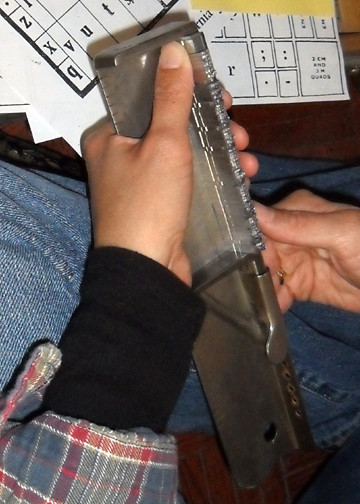Mechanical Precision

My left hand is numb. I am not used to gripping a composing stick for three hours. My kid-sized hand does not curl around it comfortably, so the metal edge digs into the webbing where my thumb meets my hand. But this is how it’s done – you hold the type in place with your thumb while setting and justifying. Setting the type is one thing; it is the justifying that takes time. Lots of time.
Writing is both mechanical and mystical. Pen or pencil to paper, fingertips to keyboard, inky lead type to press-fed paper. Write your name, a grocery list, your fantasy football roster – no hesitation, the words flow. Write an email to your friend, your boss, your spouse – still fairly easy, but word choice will vary by audience. Write a message in a sympathy card, a resignation letter, a 500 word essay on a topic not of your choosing – now I have your attention. The mechanics haven’t changed, but now the words take more time to pick out, and may be erased/deleted/replaced many times before you hit send or seal the envelope. Why?
When we write an email, a card or an essay, we are composing; we search for just the right word. The meaning must be clear, and word choice plays a pivotal role. I can write a phrase, “I enjoyed my walk today.” Or I can write it this way, “The warm sun and the fragrant air wrapped my daily walk in glorious springtime.” Therein lay the difference between the reader merely understanding, and the reader feeling. That is the mystique of writing.

Justify
To justify type in a composing stick means that after deciding whether the words will align left, right or center, spacers are used to arrange the type in that manner. In linear space of the longest line of type, there must also be equal spacing material. “Ems,” (called an Em due to the corresponding width of the letter M in a given typeface) are faceless lead pieces used to create the space needed to justify type. One-em, three-em, five-em pieces are gradually wider, while an “En” is half the size of an “Em,” and pieces of increasingly thinner widths are used to separate words. Last are thinner strips of lead, brass, and (the thinnest) copper that are used to fill the very last of the airspace in the composing stick.
Without these bits and pieces of metal – which bear no letters or symbols, receive no ink and make no mark – letterpress is impossible. The Ems and Ens fill the space and push the type together; if the type is not snugly justified, you may be ducking inky lead shrapnel when you turn on a motorized Vandercook press.
Choose your words
Finding the right words is like finding the right spacing material. I consider each one, trying it for fit. For some I’ll know right away if it is a fit, or if I need to move on. For others I’ll go along a while fitting pieces until I come back and realize, no, this other piece is better here. Function words and slim copper spacers; it is precise work, done without a guide, by feel. The goal is the same – to create something that is a product of body and mind, mechanics and mystery. The arts of writing and letterpress are both.


[…] in the space, much like the spacers used to snug up the type in the composing stick (as I described here two weeks ago). I sense a pattern of parts coming together to not just make a whole, but to make […]